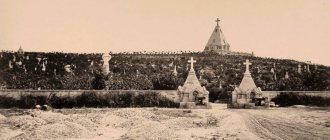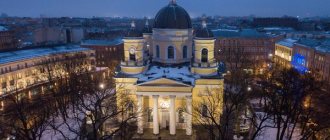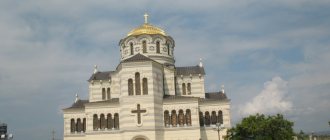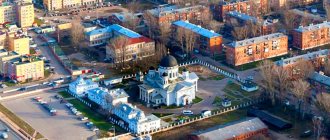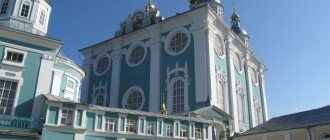Most often, having heard about the Vladimir Cathedral in Sevastopol, city guests imagine a majestic temple on the Chersonesos Peninsula that attracts numerous pilgrims to Crimea. But, besides it, there is another, no less important cathedral in the city with the same name. It is located in the very heart of the legendary city. This temple stands on the top of a hill called Central. His address is Suvorov Street, 3.
This temple is famous for being a tomb. 4 famous admirals are buried here. At the beginning of the 19th century, a decision arose to build a temple to perpetuate the baptism of Prince Vladimir, popularly known as the Red Sun, in Chersonesos. Funds for its construction were collected throughout Russia for several years. Now the cathedral is the tomb of admirals, combining a functioning temple and a museum.
Construction and consecration of the cathedral
The time of occupation of the city became cruel for the future Vladimir Cathedral. It was desecrated and robbed by marauders - French soldiers. To rip the golden epaulettes off the admirals' uniforms, they broke the lids of their sarcophagi. With the conclusion of the Paris Peace in 1856, Sevastopol returned to Russia again. In 1858, the cathedral was cleared of ruins. It was completed according to the design of the architect A. A. Avdeev, slightly revised from the original plans, and consecrated in honor of the Baptist of Rus', Equal-to-the-Apostles Vladimir. This happened in 1888.
The names of the heroes of the first defense of the city were listed on marble plaques on the walls inside the temple. Later, the temple was used several times as a tomb. 9 more officers were buried there. The last time the temple was used for burial was in 1920, before the establishment of Soviet power in Crimea.
Cathedral of Admirals
Admiral Nakhimov on the Malakhov Kurgan
On the southern coast of the Crimean peninsula, where the waves of the Black Sea crash loudly against the coastal cliffs, lies the beautiful city of Sevastopol. In its very center, on a high hill, stands the huge marble cathedral of St. Vladimir, the Grand Duke, through whose efforts the Christian faith came to Russian soil. The bodies of famous admirals (the military rank of the highest officers in the navy. The one who commands the captains. - Ed.) are buried in this temple. Without sparing their lives, these glorious sailors fought for the Fatherland. And although more than a century and a half has passed since the first of them was buried here, there is no place in the city that the people of Sevastopol would reverence more than this cathedral, which became the last earthly refuge of brave heroes.
Heir to Chersonesus
In the city limits of Sevastopol, today you can admire the majestic ruins of the ancient settlement. This is Chersonesos, a city built by the ancient Greeks almost two and a half thousand years ago. After them, the Romans were the masters of Chersonesus for a long time, then the city passed to the Byzantine Empire, then to its fragment - the Principality of Theodoro.
But no matter how the state affiliation of Chersonesos changed, for almost one and a half millennia (that is, three-quarters of its historical destiny) it was a Christian city. Faith in Jesus Christ came here in the very first century of the existence of Christianity. And subsequently, it was here that the Chersonese priests taught Grand Duke Vladimir Svyatoslavich the Orthodox faith, which he would spread throughout the Russian land... Twice the city was subjected to devastating attacks by the troops of the Golden Horde - a powerful state of steppe nomads - and by the middle of the 15th century it ceased to exist.
Christianity left the city only along with life. For three centuries, the place where temples once stood, where the city market was noisy, where ships from distant countries came, stood in desolation. When Crimea became part of the Russian Empire, there was only a small village here. And finally, in 1783, Sevastopol was founded on this site.
From the first years of its life, the new city became a stronghold of Orthodoxy. Newly built churches appeared here very quickly - already at the end of the 18th century. The first stone house in Sevastopol is the St. Nicholas Chapel. And, of course, from its birth, Sevastopol was intended to be the main base of the Russian Black Sea Fleet - warships that protected Russian shores and waters from enemy attacks. Here everything was built and created for his sake. From the very beginning of the history of Sevastopol, most of its inhabitants were sailors. And today among the residents of Sevastopol there are a lot of people of naval professions - sailors, officers, port workers, divers, mechanics, naval aviation pilots... You can’t remember them all right away, there are so many of them, naval ones. Probably about half the city.
Heart of the fleet
Very soon the people of Sevastopol realized themselves as heirs of the ancient Chersonesos tradition. Already in the 1820s, the first large archaeological excavations began. People decided to better learn the history of the ancient settlement on the territory of their city. Moreover, it was not just anyone who suggested carrying out the excavations, but one of the commanders of the Black Sea Fleet!
The naval officers understood very well that the fleet was the main guardian of Crimea not only as a vast territory, but also as a place where many Orthodox people gave their lives for the return of the faith of Christ to this land.
Sevastopol, the front line of Russian defense, the heart of the navy, lived in constant anticipation of war. It could start at any time.
In 1833, command of the Black Sea Fleet was entrusted to Admiral Mikhail Petrovich Lazarev. He held this high position for 18 years, until his death. The years of his command will later be called Lazarev’s time, he did so much for the city and the fleet.
He organized ship races and trained naval gunners so that they set records for rate of fire and accuracy. Replaced the old onboard guns with guns of the latest design. He erected powerful forts at the entrance to Sevastopol Bay - coastal fortresses, armed with a large number of cannons. He trained a whole galaxy of brilliant followers.
6 years before assuming the post of commander of the Black Sea Fleet, Lazarev participated in the Navarino naval battle between the Turkish-Egyptian fleet and the combined Russian-English-French squadron. After a 4-hour artillery battle, the enemy fleet was almost completely destroyed. Lazarev then commanded the battleship* Azov. A few years later, he will make his closest assistants the three officers who participated with him in this glorious battle. So the Azov crew gave the Black Sea Fleet famous admirals: Nakhimov, Kornilov, Istomin.
Lazarev passed away peacefully in 1851. And two years later the terrible Crimean War broke out. It began with the conflict between Russia and Turkey, but then the armies of several European states joined our enemy. It was then that the military art of Lazarev’s students came in handy for Russia.
Fight for Sevastopol
The outbreak of hostilities in the Crimean War brought two triumphs to the Russian fleet. November 5, 1853, the newest steam frigate (a frigate that, in addition to sailing weapons, had a steam engine and paddle wheels. - Ed.)
"Vladimir" entered into battle with the Turkish combat steamer "Pervaz-Bahri". “Vladimir” was commanded by Lieutenant Commander Grigory Butakov. On board his ship was Admiral Vladimir Alekseevich Kornilov. Butakov and Kornilov saw: against the 9 guns of the Vladimir, the Turkish steamer could use its 10 guns. But they resolutely attacked the enemy on the high seas. A fierce artillery duel lasted for two hours. As a result, Pervaz-Bahri lowered the flag, which in the language of naval battles means surrendered. The collision of "Vladimir" and "Pervaz-Bahri" entered the world history of naval battles as the first battle of steam ships. The Russian fleet emerged from it with honor.
On November 18, 1853, the squadron of Admiral Pavel Stepanovich Nakhimov attacked the enemy fleet, which was waiting out bad weather in a bay near the Turkish city of Sinop, and destroyed it. The brilliant defeat of the Turks became consolation and encouragement for the Russian Black Sea sailors. They snatched one more breath of glory in battle - before the time of sorrow came and the night of severe trials fell on the Empire's fleet.
Russia had enough forces to defeat Turkey. But in the spring of 1854, England and France entered the war and sent their troops to help Turkey. In September, the Anglo-French armada landed troops on the Crimean coast. The combined invasion army that came ashore consisted of 62,000 men. She moved towards Sevastopol.
Sevastopol Bay knew the Black Sea Fleet in its glory days. On September 11, 1854, she witnessed his death. Early in the morning, at the entrance to the bay, Russian sailors sank five battleships and two frigates with their own hands (the frigate differed from the battleship in its smaller size and artillery armament, but was faster and more maneuverable. It was intended for long-range reconnaissance and conducting independent combat operations. - Ed.). A little later, at the bottom of the Sevastopol Bay, next to their brothers, six more giants rested: three battleships and three frigates.
Mighty warships, the glory and pride of the Black Sea Fleet, not yet old at all, were covered with cold water...
It was necessary. A merciless enemy surrounded the southern part of the city - at that time it was called the “Ship Side”. From the sea, the Sevastopol Bay was blocked by a huge Anglo-French fleet. He had an overwhelming superiority in ships, many of which were superior in their combat qualities to the best ships of the Russian Black Sea Fleet. The chief of staff, Vice Admiral Kornilov, proposed an attack. Let the fleet perish! But he will still die in battle, with honor, inflicting deep wounds on the enemy.
However, the command of the Russian combat forces in Crimea gave a different order. It did not want to needlessly lose officers and sailors who had high combat training. Therefore, he ordered the scuttling of large ships at the entrance to the bay so that with their hulls they would block the enemy’s access to it. The guns were removed from them and placed on defensive structures. The crews were sent to fight on land.
Kornilov said then that sailors are needed to protect the city, where their houses are located, and many have families. The guns removed from the sunken ships were installed on earthen bastions (a defensive structure whose walls were formed by earthen ramparts. - Ed.) Most of the city’s defenders were naval officers and sailors. The organizers of the defense were the beloved and respected admirals - Nakhimov, Kornilov, Istomin. All are Lazarev's comrades.
Opponents stormed Sevastopol several times. The admirals personally participated in repelling the attacks.
The first bombardment and decisive assault were planned for October 5, 1854. In the morning the cannonade began. It wasn't just the field guns that hit. The enemy fleet approached the city, and the mighty airborne artillery brought down a fiery tornado on the Sevastopol bastions. In response, Russian guns struck. The result of the artillery duel stunned the enemy. Having suffered huge losses, the attackers called off the assault.
This success came at a heavy price. Admiral Kornilov was mortally wounded on Malakhov Kurgan. I just managed to say: “Defend Sevastopol!” - and lost consciousness. At the dressing station, he came to his senses, took communion and sent to warn his wife about the wound he had received. Dying, Admiral Kornilov said: “Tell everyone how pleasant it is to die when your conscience is calm. God bless Russia and the Tsar! Save Sevastopol and the fleet! The Sevastopol defense did not waver. Nakhimov took command of the fortifications. He gave the defense of the key position - Malakhov Kurgan - under the leadership of Istomin. He successfully defended the mound for six months. Only in March 1855, during enemy shelling, Admiral Istomin died.
A particularly difficult battle took place on May 26, 8 months after the start of the siege.
Ignoring losses, the enemies attacked Malakhov Kurgan. Nakhimov himself directed the artillery fire on the mound. He was supported by the artillery of the remaining Russian ships from the Sevastopol Bay. The enemy attack was successfully repulsed. Nakhimov threw the newly arrived forces into a counterattack. The battle lasted for many hours. The enemy failed to take Malakhov Kurgan...
Admiral Nakhimov soberly assessed the situation. The city heroically holds out, repelling assaults, but the enemy’s forces are increasing, and the garrison is melting, and no major reinforcements are expected. Sevastopol is destined for a bitter fate - there is no one to hold it. But this does not relieve combat commanders from their military duty - to fight while there is even the slightest opportunity for this. And encourage those who doubt it by personal example: if the admiral himself does not show fear and doubt, then the ordinary defenders of the city have no reason to do so!
Nakhimov became the soul of the defense of Sevastopol for many months. He behaved in positions with such courage that soldiers and sailors sometimes forcibly took him to safety. The enemy riflemen especially hunted for Russian commanders. Therefore, even officers, not to mention generals and admirals, wore simple soldier’s overcoats for camouflage. And only Nakhimov appeared on the bastions every day in full uniform. This meant a lot for the morale of the defenders. Soon Nakhimov became a living symbol of perseverance and courage.
On June 28, 1855, on Malakhov Kurgan, Nakhimov inspected enemy positions. His tall, stooped figure in a uniform with admiral's epaulettes glowing in the sun was an excellent target right in front of the French battery. The officers urged Nakhimov to bend down or go behind the bags of earth. Nakhimov, without answering, stood completely motionless and looked through the telescope... The French marksman's bullet pierced Nakhimov's head. Life left the admiral's body in an instant. The brave warrior fulfilled his duty to the end, and the Lord delivered him from physical and mental torment.
The people of Sevastopol lost their leader. Two months later, the enemies occupied the southern part of Sevastopol, losing more than 10,000 people in the last battle...
Tomb of the naval commanders
Russian society did not perceive the fall of Sevastopol as a shame. On the contrary, the defenders of the city were praised for their unparalleled courage. For 349 days they repelled the superior forces of the strongest powers in Europe! The defense of Sevastopol, despite its sad outcome, entered the annals of Russian military history as a heroic deed worthy of all respect.
At that time, three of Admiral Lazarev’s pupils who died on the Sevastopol bastions - Kornilov, Istomin, Nakhimov - were honored with special reverence. The people of Sevastopol wanted to perpetuate the memory of these brave and selfless people in such a way that the civil feat of their courage would be combined with the Christian feat of their faith. After all, all four were leaders of the Orthodox army, they organized a defense and fought not just for a militarily important city, but for the source of Russian Orthodoxy, where Saint Prince Vladimir once learned Christianity.
Vladimir Cathedral of Sevastopol
A surprisingly beautiful way to achieve this goal was found. Thirty years before the heroic defense of Sevastopol, the idea was born to build a cathedral in the city in the name of St. Vladimir. It came from Emperor Alexander I and combat admiral Alexei Samuilovich Greig. Later, she was supported by the next Russian monarch, Nicholas I. He ordered the architectural design of the cathedral to be drawn up, and the Russian people collected money for its construction from the whole world, as many as they could give. Three years before the Crimean War, the first work began. It was then that Admiral Lazarev died. He was honored for his great services to the fleet and the city: the remains of the naval commander were buried in a crypt at the site of the construction of the Vladimir Cathedral. After the war began, Archbishop Innocent of Kherson and Tauride consecrated the foundation site of the cathedral.
At the time of the death of admirals Kornilov, Istomin and Nakhimov, the temple did not yet exist. But the very place where its majestic building was to rise in the future looked in the eyes of the townspeople as a center of faith, hope and love. Faith in God, hope for His help, love for Him and for our great city. Therefore, the bodies of three Orthodox military leaders who honestly gave their lives for their faith and fatherland were buried here.
What could be more natural? What could be more correct? Here you can see some very deep folk feeling: to combine the holiness of the place and the good glory of the individuals who fell on the battlefield not only as military leaders, but also as national heroes. After all, the Church is the focus of the people, the place of their spiritual unity, the stronghold of the best that is in them.
The Vladimir Cathedral is large in size and distinguished by its luxury and sophistication of decoration. Construction proceeded slowly. Only in 1881 was the lower church consecrated, and in 1888 - the upper one. Emperor Alexander III, who occupied the Russian throne at that time, ordered to perpetuate the memory of not only the admirals, but also all the heroes of the Sevastopol defense: their names were carefully recorded on marble plaques in the cathedral.
Long before the Church of St. Vladimir rose above Sevastopol in all its grandeur, the townspeople began to see it as the tomb of glorious naval commanders. Or, more simply put, the Cathedral of Admirals. Therefore, in addition to the four famous personalities themselves buried here in the 1850s, the people of Sevastopol subsequently gave the same honor to several other outstanding naval commanders.
Thus, Rear Admiral Pyotr Aleksandrovich Karpov, the last commander of the Malakhov Kurgan, a cavalier of St. George, who happily survived the defense of Sevastopol, and Admiral Pavel Aleksandrovich Pereleshin, a participant in the Battle of Sinop, a cavalier of St. George, who received serious wounds during the defense of Sevastopol, rested in the Vladimir Cathedral. After them, several more admirals found their final refuge here. A total of 13 admirals rest under the arches of the cathedral.
* * *
Sevastopol is a special city. Here the holiness of the Orthodox faith is combined with the military valor of the Russian people. The cross triumphed here over pagan darkness in ancient times - many centuries earlier than Rus' was baptized. It was hard for him to stand here - on the border along which the divide of different religions runs. But at all times there were people ready to defend Sevastopol at any cost. Even at the cost of his own life. Vladimir Cathedral became a real monument to their strong faith and military valor.
Drawings by Ekaterina Gavrilova
Workshops, military hospital, museum
In the 30s, the building belonged to OSOAVIAKHIM. It housed aircraft engine workshops. During the Great Patriotic War, the cathedral became a hospital. Alas, it was again badly damaged by enemy bombing. The year 1965 was marked for the temple by the decision to restore it. Later it became one of the buildings of the Museum dedicated to the heroic defense and liberation of Sevastopol.
Unfortunately, restoration of the tomb as such began only in 1991. A special commission that examined the burials found rubbish and bone fragments in the crypts. The ceremonial reburial of the admirals took place in 1992 in the lower church of the cathedral, dedicated to St. Nikolai.
St. Vladimir's Cathedral on Sinopsky Descent today
Today, the Vladimir Cathedral with the tomb of the admirals is a monument of architecture and history. We are revered not only by believing citizens, but also by tourists who want to learn more about the hero city of Sevastopol. His story.
The majestic building in the Old Russian and Byzantine style has a single dome. Worship services are held in the upper part. At the bottom, as before, is the tomb of the admirals. In total, 13 people are buried there.
On the northern and southern sides of the cathedral, diorite slabs were placed with the names of the admirals, whose ashes rest in the tomb. On the top floor there are also marble slabs with the names of 72 officers who took part in the Crimean War.
More temples of Sevastopol:
- Intercession Cathedral
- Church of St. Nicholas the Wonderworker
The interior decoration of the lower and upper temples is significantly different. The upper part is expressive and monumental. Thanks to a system of vaults and columns, grouped in groups of 4, supporting the domed vaults. The columns are lined with marble, which makes the appearance richer and more luxurious.
The small windows are glazed with multi-colored glass and do not let in much light. But I didn’t experience a feeling of gloom. This approach simply emphasizes the “antiquity” of the structure. The iconostasis is made of Carrara marble. Does not differ in large sizes. Single-tier. Thanks to this, the niche with the altar is not closed. You can freely enjoy the paintings.
The lower temple is modest and fully corresponds to its purpose. Simple snow-white columns. No paintings. Wide vault and the most simple iconostasis. , so to speak, a black marble cross. Below it are the graves of four admirals.
Icons (shrines) of the Vladimir Cathedral on Sinop Descent:
- Confessor Roman
- Blessed Paul of Taganrog
- Fedora Ushakova.
All holy faces with particles of relics.
Again a temple, but also a museum
Now in the cathedral, in its upper church, dedicated to St. Vladimir, services are going on again and prayers are being heard. The traditions of the “sea” temple have been restored, as in the old days; pennants and flags of modern ships are consecrated here. Memorial services are held for the dead sailors. But the cathedral has not ceased to be an interesting and important museum.
Its lower temple offers a permanent exhibition created using materials from the collections of several Sevastopol museums. They are provided by the already mentioned Sevastopol Defense Museum, the Military History Museum of the Black Sea Fleet, the State Navy Archive, etc. The exhibition is dedicated to the history of the cathedral, tells about the architects, artists, builders and restorers who created and restored it, and recalls the heroic facts of the biographies of the admirals buried here.
How to get to the Cathedral of St. Vladimir, admiral's tomb
As stated above, the temple is located in the center of Sevastopol on the Central Hill. If you get there by car, there are parking lots on the hill, but they are few. The most spacious one is on Matrossky Boulevard, a couple of minutes walk from the cathedral.
Those who travel by public transport need to walk anywhere in the center, go up the hill (there are many stairs) and go to the temple. From any point it will not take more than 15 minutes. Expect that there are still a lot of interesting things on the Central Hill: monuments to Kazarsky and Popov, the Tower of the Winds, the Peter and Paul Cathedral, etc.
The ticket office where tickets for excursions are sold is located directly opposite the main entrance to the cathedral. Ticket price 250 rubles . The guide recruits a small group and takes them through the Upper and Lower Churches of the cathedral, telling its history. There are no excursions during services and church holidays.
How to visit the temple and museum
You can get here, to Suvorov Street, 3, by any bus or minibus that goes to the Lazarev Square stop. Usually the museum receives its visitors on any day of the week, seven days a week. You need to come here no earlier than 10 am, at which time the museum part of the cathedral opens. On days of morning services, the temple may be open earlier, at 7:00. The schedule of services can be easily found on the official website of the temple. The museum exhibition closes at 18:00. You can buy tickets to get into the lower temple and listen to the guide until 17:30. It is important to consider: services held here may change the museum’s opening hours.
There is a legend that the heroic admirals buried in the cathedral-tomb to this day protect Sevastopol, helping its defenders repel even the most formidable attacks of any enemies. There is some truth in this beautiful tale. Stories about the heroes of the past have invariably inspired and continue to inspire their growing young followers, helping them to remain worthy of the great glory of their ancestors in everything.
Teacher and students
Fate gave these three students of Lazarev the opportunity to pass through the dangers of Navarino, Sinop and Sevastopol. Defending the latter, the admirals did not spare their lives. Their teacher had already been buried in the foundations of the Vladimir Cathedral under construction for three years by that time.
First, the grave of Vladimir Kornilov was added to Lazarev’s grave - the English core overtook him during the first, most terrible bombardment by the Allies, who besieged the sea fortress. Then on March 7, a cannonball tore off the head of Rear Admiral Vladimir Istomin. When his body was lowered into the “admiral’s” crypt, Nakhimov said: “By the unanimous desire of all of us, his former colleagues, we buried his body in an honorable and sacred grave for Black Sea sailors, in the crypt where the ashes of the unforgettable Mikhail Petrovich lie and... the deceased Vladimir Alekseevich. I was saving this place for myself, but I decided to give it up.”
Admiral Pavel Nakhimov himself died in the last weeks of the First Defense - a French sniper sent a well-aimed bullet to his temple.
Tourist information
Vladimir Cathedral, like the entire reserve complex, can be visited at any time of the year. Evening service in the temple begins at 17:00. Working days:
- Monday;
- Tuesday;
- Thursday.
Morning Liturgy can be attended at half past eight in the morning twice a week:
- on Wednesday;
- on Thursday.
On Saturday, the liturgy is held at 08:00, and the all-night vigil begins at 16:00. On Sunday there are two liturgies:
- early – at 06:00;
- Late – at 09:00.
The evening service begins at 5:00 pm on Sunday.
The contact telephone number for those wishing to receive more detailed information is +79781102621.
The fate of God's faithful servant Roman Bear
For a long time, the godson of John of Kronstadt, Roman Medved, a graduate of the Theological Academy in St. Petersburg, served in the Vladimir shrine. According to the testimony of the priest Roman, during services he saw the Monk John soaring in the air.
In 1907, Roman Medved became rector of the Tomb of the Admirals. As a dean priest, Roman visited with the sailors of warships in Greece, where he had the honor of venerating the relics of Nicholas the Ugodnik. The rector of the cathedral earned special respect among sailors after the uprising of sailors on the ship “St. John Chrysostom,” when he spent the whole night receiving the rebels sentenced to death for confession and communion.
Other articles about the Orthodox faith:
- What are the relics of saints
- What does the halo over the heads of saints mean?
- How to get to heaven
The revolution of 1918 forced the priest to leave with his family for Moscow, where he became rector of the Intercession Cathedral. A difficult fate awaited the priest ahead. Constant arrests, a death sentence commuted to 10 years of life in a concentration camp, after which he becomes a monk and dies under the name Joseph.
Icon of the Holy Confessor Roman
In August 1999, a piece of the relics of St. Joseph was transferred to the Tomb of the Admirals, where it is kept to this day.
How to get (get there) to St. Vladimir Cathedral on Sinopsky Descent in Sevastopol
There are several options for getting to the Vladimir Cathedral (Tomb of the Admirals) in Sevastopol. On foot from the Artillery Bay pier you climb the Sinop Stairs. From the Grafskaya pier you go through Nakhimov Square. Turn left towards Matrossky Boulevard. Walk along Sovetskaya, turn onto Voronin and, passing the Lenin monument, exit to Vladimirsky Boulevard.
I recommend: excursion to the bays of Sevastopol for 22 rubles
From the train station it is easy to get there by public transport. Buses No. 29, 32, 109 and 107 go to the Lenin Komsomol Square stop. Trolleybuses - 1, 3, 7 and 9. After 200 meters, go left along the Marata staircase street.
New look
The war ended, and work on the construction of the temple resumed. The famous academician, architect A.A. Avdeev was invited.
At that time he lived in Sevastopol and worked on the creation of the Church of St. Nicholas, which is at the Brotherly Cemetery. Avdeev had different views on construction than the original author of the project, Ton K.A., a supporter of the Russian-Byzantine style with an indispensable five-domed structure.
The academician carefully studied the existing plan and, on its basis, drew another one, in the spirit of traditional Byzantine church architecture.
Construction of the cathedral began on the existing foundation. According to the architect's idea, it was a single-domed temple with triangular fronts on the facades and an octagonal drum. The walls were made of light limestone, which was mined in the same area. Dark columns with carved capitals, which served as supports for the arches, stood out beautifully against its background.
In 1881, the construction of the lower part of the cathedral was completed, and in 1888 the upper part was also erected. At this point Avdeev A.A. already died. The temple became a monument to war heroes. Four marble slabs were installed on the walls, on which the names of the admirals and the dates of their deaths were written. Their graves were connected into a common tomb in the shape of a large black cross. In the middle there was a golden cross with a laurel wreath.
For several decades the temple was used for its intended purpose. Before the revolution, memorial burials took place here. But in 1930, after the Bolsheviks came to power, it was closed by order of the authorities.
For many years, aircraft engine workshops and warehouses were located here. The temple was seriously damaged during the battles of 1941-1942, the northern façade, roof, cross were destroyed, the paintings were severely damaged, and most of the paintings were lost.
Where to stay
There are a huge number of cafes and restaurants nearby where you can have a quick and tasty snack or spend an evening with friends.
You don't have to go far to find accommodation for the night. Hotels and inns are at your service: “Dolphin”, “Old Town”, “Evening City”. A day here will cost from 2.5 to 13 thousand rubles.
Less comfortable, but cheaper housing is offered by the private sector, hostels, and guest houses. It costs from 500 rubles to 4 thousand. If you book your place in advance, you can get a good discount.


